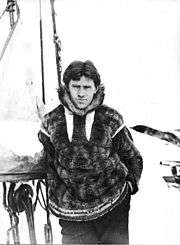Ejnar Mikkelsen

Ejnar Mikkelsen (23 December 1880 in Vester-Brønderslev – 1 May 1971 in Copenhagen), was a Danish polar explorer and author. He is most known for his expeditions to Greenland.
Biography

He was born in Vester Brønderslev, Jutland. He served in the Georg Carl Amdrup expedition to Christian IX Land, East Greenland (1900), and in the Baldwin-Ziegler expedition to Franz Joseph Land (1900–02).[1]
With Ernest de Koven Leffingwell he organized the Anglo-American polar expedition which wintered off Flaxman Island, Alaska, in 1906-07. They lost their ship, but in a sledge journey over the ice they located the continental shelf of the Arctic Ocean, 65 miles (105 km) offshore, where in 2 miles (3 km) the sea increased from 50 meters (164 ft) to more than 690 meters (2264 ft) in depth.[2]
Organizing an expedition to map out the northeast coast of Greenland, to recover the bodies of Mylius-Erichsen and Lieutenant Höeg-Hagen and their records, Mikkelsen wintered 1909-10 at Shannon Island, East Greenland. His wooden ship, the Alabama, was trapped in the ice of Shannon and, while he was exploring, the rest of the party returned home on a whaler. Remaining with his engineer, Iversen, Mikkelsen succeeded by a series of hazardous sledge journeys in recovering the lost records and in disproving the existence of Peary Channel.[2]
The two explorers returned to Shannon island to find the crew gone, but, they had salvaged timbers and planking and erected a small cottage. Mikkelsen and Iversen then spent two winters at the cottage before they were rescued, in the direst of extremities, by a Norwegian whaler in summer 1912.[2] The so-called Alabama cottage has survived, intact, and was photographed during a visit by Danish Navy inspection ship Ejnar Mikkelsen in September 2010.[3]
In 1924, he led an expedition to settle what later came to be Scoresbysund.[2]
In 1932 he led the 'Second East-Greenland Expedition of the Scoresbysund Committee' that carried out the first archaeological excavations on the Skaergaard Peninsula by the shores of the Kangerlussuaq Fjord.[4]
In 1970 on his 90th birthday a national tribute was paid to him in Denmark, he died in Copenhagen a few months later on 1 May 1971.[5]
In 2009 the Royal Danish Navy named the second Knud Rasmussen class patrol vessel the HDMS Ejnar Mikkelsen.[6]
The Ejnar Mikkelsen Range is named after him.[7]
Works
- Conquering the Arctic Ice (London, 1909)
- Lost in the Arctic (1913) Some of his Greenland expeditions are recounted here.
- Mylius-Erichsen's Report on the Non-Existence of Peary's Channel (1913)
- Tre Aar par Grönlands Ostkyst (1914)
- Norden For Lov og Ret, a story (1920)
- translated as Frozen Justice (1922)
- John Dale, a novel (1921)
- Two Against the Ice, with a foreword by Lawrence Millman (Steerforth Press, 2003)
Awards
- 1933 Hans Egede Medal of the Royal Danish Geographical Society. [8]
- 1935 Patron's Gold Medal of the Royal Geographical Society
See also
References
- ↑
-
 Rines, George Edwin, ed. (1920). "Mikkelsen, Ejnar". Encyclopedia Americana.
Rines, George Edwin, ed. (1920). "Mikkelsen, Ejnar". Encyclopedia Americana.
-
- 1 2 3 4 Mills, William James (2003) "Mikkelsen, Ejnar (1880-1971)" Exploring polar frontiers: a historical encyclopedia, Volume 1 pp 426 ff, ABC-CLIO ISBN 1-57607-422-6, ISBN 978-1-57607-422-0
- ↑ Danish Armed Forces, FORSVARET, Greenland Command, press release, 11 September 2010, Ejnar Mikkelsen back at Shannon Island after 98 years Google translate, 26 Sept 2010.
- ↑ Skaergaard history
- ↑ "Captain Einar Mikkelsen." Times [London, England] 5 May 1971: 18. The Times Digital Archive. Web. 22 Mar. 2014.
- ↑ "Update: Denmark's Arctic Assets and Canada's Response — Northern Deployment 2009: Danish Navy & CCG in the High Arctic". Canadian American Strategic Review. September 2009. Archived from the original on 2009-09-12.
- ↑ "Ejnar Mikkelsen Fjeld". Mapcarta. Retrieved 3 August 2016.
- ↑ (in Danish)
Further reading
- Meddelelser om Grønland (50 volumes, Copenhagen, 1876–1912)
-
 Rines, George Edwin, ed. (1920). "Mikkelsen, Ejnar". Encyclopedia Americana.
Rines, George Edwin, ed. (1920). "Mikkelsen, Ejnar". Encyclopedia Americana.

